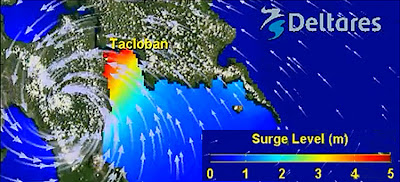Typhoon Haiyan, which devastated the Philippines in November, is one of the strongest storms ever recorded at landfall. So how did this typhoon come about?
Tropical storms (hurricanes, cyclones or typhoons, depending which part of the world you're in) can only occur when conditions are just right. These are the ingredients of a typhoon:
1. Warm ocean water (at least 27C to a depth of 50m)
2. At least 5 degrees/ 500km away from the equator where Corioli's force is strong enough to cause rotation (hurricanes rotate ACW in the northern hemisphere and CW in the south)
3. An unstable/steep lapse rate (the change in temperature with height) to encourage convection
4. Low vertical wind shear (the change in wind speed with height), which could prevent convection and disrupt the structure of the storm
5. High humidity in the mid-troposphere (about 5km up)
6. A tropical/easterly wave/disturbance (an area of low pressure with clouds and thunderstorms, around 100 develop every year but only 10 meet the right conditions to turn into a hurricane).
Even when all these conditions are met, a hurricane may still not develop. However, if it does, this is what happens:
But why was Typhoon Haiyan so devastating, what made it one of the strongest typhoons ever recorded?
Well, to start with a single hurricane vary in size and intensity, when they reach land they are often not at their greatest strength (Katrina reached Category 5 on the Saffir-Simpson Hurricane Scale when she passed over the Gulf of Mexico but had fallen to a 3/4 by the time she reached Louisiana). Also, when they reach land and move away from their fuel source of warm water they quickly lose some of their strength.
However, you can see from the image below, it just so happened that when Typhoon Haiyan hit the Philippines it had reached it's peak intensity: a Category 5 with sustained wind speeds up to 200mph. Haiyan was able to reach this intensity because she formed over a wide expanse of open ocean with perfect hurricane conditions; one is that there was very little wind shear in the area to disrupt the convectional air flows and rotating winds.
The typhoon also had a plentiful supply of warm water, not just within the first 50m, but unusually (some have linked this to anthropogenically influenced climate change) the ocean was warm enough for hurricane formation down to a depth of 100m! Once the storm whipped up the top layer of water there was still a plentiful supply of heat below giving the typhoon more and more energy. Check out the map below:
Not only had this typhoon reached it's full strength when it hit the Leyte and Samar provinces of the Philippines but it brought a huge storm surge with it, which was magnified by a deadly combination of wind direction and coastal topography. Along most of the eastern side of the Philippines the ocean is very deep, making storm surges unlikely as waves need progressively shallow water to build any height. However, the orientation of Haiyan as she hit land meant that north-westerly winds drove the storm surge into San Pedro Bay which, although mostly deep water, becomes much shallower and also narrower to the north. The bay acted liked a giant funnel, causing the tsunami-like surge to reach 5 metres in height.
So far, the death toll is estimated to be over 5000, 600 000 are homeless, while the economic costs to the Philippines range from $5-14 billion. The super-strength and huge size of this storm (estimates of her diameter range from 6-800km) and the devastating surge it brought with it were bound to have a severe and lasting impact. But maybe if the archipelago has been better prepared the damage and loss of life could have been mitigated to some extent. Although some preparations were made (e.g. the evacuation of 1 million people and government announcements telling people to prepare), it was no where near enough. Firstly no one was expecting the storm surge so, for example in Tacloban several thousand people took shelter in a big indoor 'stormproof' stadium. Sure enough, the roof stayed on, but people were killed by the storm surge which flooded through the bottom.
The typhoon also hit one of the poorest regions of the Philippines, where people lived in flimsy make-shift shanty-towns and even properly built structures do not conform to an sort of typhoon proof regulations as they surely should do, being in a high risk area. Low levels of education and a corresponding lack of appropriate language grading by the authorities also meant that despite being warned about an impending storm surge many residents did not realise what this meant so failed to take even simple potentially life saving measures such as going upstairs in the stadium instead of staying on the ground floor until it was too late. On top of all this, the Philippines has a very high population density, over 300 people per square km, compared to around 250 in the UK, putting a huge number of people at risk.
In conclusion, a combination of physical and human factors, summarised below, made Haiyan one of the worst natural disasters we've seen in a long time.
- Open ocean with no land masses
- Very little wind shear
- Very warm water down to 100m
- Made landfall at full strength
- Funnelling effect in San Pedro Bay
- Lack of preparation
- High population density
Lets just hope that some lessons are learned for next time. In the mean time, please donate generously to help the survivors. You can do so here.
Finally, check out this page which has some great maps explaining the path and impact of the typhoon as well as some before and after satellite photos:
References
http://www.theweatherprediction.com/tropical/
http://www.aoml.noaa.gov/hrd/tcfaq/A15.html
http://agora.ex.nii.ac.jp/digital-typhoon/help/world.html.en#id2
http://www.theweatherprediction.com/tropical/
http://en.wikipedia.org/wiki/File:Haiyan_2013_track.png
http://archives.starbulletin.com/2002/05/19/news/index2.html
http://scienceblogs.com/gregladen/2013/11/11/why-was-typhoon-haiyanyolanda-so-powerful-and-is-this-a-trend/
http://www.livescience.com/41025-typhoon-haiyan-most-intense-storm.html
http://www.economist.com/news/asia/21589916-one-strongest-storms-ever-recorded-has-devastated-parts-philippines-and-relief
http://www.dutchwatersector.com/news-events/news/8391-typhoon-haiyan-pushed-devastating-5-m-high-storm-surge-into-tacloban-city-philippines.html
http://www.usatoday.com/story/news/world/2013/11/22/philippines-typhoon-lessons-learned/3664883/
http://www.economist.com/news/leaders/21589883-responding-disaster-essential-so-preparing-next-stress-test






